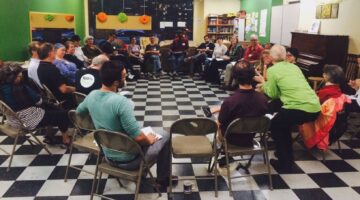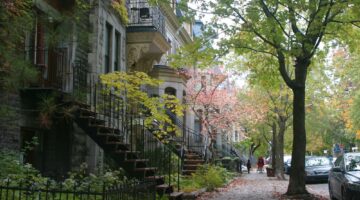




Communauté Milton Parc, Montreal
Main objectives of the project
In the 1970s, residents of Milton-Parc rallied against the proposed demolition of their neighborhood, ultimately transforming it into the most extensive cooperative housing endeavor in North America. Presently, the Communauté Milton-Parc / Milton Parc Community (CMP) accommodates over 1500 individuals, structured into a federation comprising 15 housing cooperatives, 6 nonprofit housing initiatives, and a community-operated entity overseeing commercial properties. Notably, the project adopts a distinctive legal framework akin to a community land trust, safeguarding six downtown Montréal blocks from potential speculation and gentrification. Rigorous standards for resident selection prioritize households with limited incomes. Serving as a significant model for communal land ownership, Milton Parc has inspired similar radical housing initiatives worldwide, including the establishment of the Champlain Housing Trust in Vermont, now recognized as the largest community land trust in the United States.
Date
- 1979: Implementation
Stakeholders
- Promotor: Communauté Milton Parc
Location
City: Montreal
Country/Region: Canada, Montreal
Description
The genesis of the Milton Parc project traces back to a tumultuous period in 1968 within a predominantly working-class and immigrant-inhabited district of Montréal. At that time, a real estate developer, now known as Concordia Estates Ltd., embarked on acquiring the majority of the neighborhood with plans to replace its 19th-century greystone Victorian buildings with a sprawling complex encompassing shopping centers and office towers.
Over the span of 1968 to 1979, a coalition of Milton Parc residents orchestrated a series of mobilizations, comprising protests, marches to City Hall, and the establishment of essential community services like health clinics, daycares, and food-buying cooperatives. The commencement of Phase I of the developer's project in 1972 saw some residents forcibly evicted from their dwellings, leading to various forms of resistance, including the occupation of vacant houses and a sit-in at the Concordia offices, which culminated in the arrest of 56 peaceful demonstrators.
Subsequent years witnessed sustained protests that garnered attention from the developer's financial backers, prompting some to withdraw their support. Concurrently, external factors such as the 1972 international oil crisis and preparations for the 1976 Montréal Olympics led to economic instability and inflation, diminishing the value of Concordia Estates' funding and impeding the realization of their full development plan.
In 1977, amidst a shifting political landscape with the Parti Quebecois ascending to power in Quebec's provincial government and economic turbulence prompting businesses to flee the region, Concordia Estates sought to divest the depreciating Milton Parc property. Capitalizing on their decade-long organizing experience and bolstered by political changes, Milton Parc residents rallied support from various stakeholders, including a local heritage conservation nonprofit and a newly established Technical Resource Group comprising financial consultants, lawyers, and architects.
The pivotal moment arrived in 1980 when the Canada Mortgage and Housing Corporation (CMHC) officially endorsed the residents' Action Plan, paving the way for neighborhood renovations from 1980 to 1987. The financing model hinged on CMHC's purchase of the entire Milton Parc property in 1979 for USD $4.8 million, supplemented by over USD $5 million in subsidies from the CMHC, the Quebec Government, and the City of Montréal. The remaining expenses were covered through mortgage loans, with the CMHC ensuring favorable interest rates over a 35-year period to maintain rent affordability based on original rates, inclusive of minor increases to cover expenses.
Legally, the establishment of the Communauté Milton-Parc (CMP) in 1987 introduced a novel legal framework, delineating it as a "condominium for social purposes." Under this structure, housing cooperatives and nonprofits collectively own the properties, while sharing responsibilities for maintenance and services. The CMP oversees neighborhood transformation through a community-run nonprofit, resembling a community land trust model but with collective ownership of public spaces and individual ownership of buildings by cooperatives. Strict regulations outlined in the CMP's Declaration of Co-ownership safeguard against unauthorized transactions, ensuring adherence to democratic principles and self-management within the cooperatives. This intricate legal and financial arrangement underscores the residents' commitment to preserving affordable housing and fostering community-driven development.
The CMP shares similarities with a community land trust (CLT), but there are distinct differences in ownership structures. Typically, in a CLT model, the land is solely owned by the trust. However, in Milton Parc, the CMP collectively owns the land surrounding each building, including streets and public spaces, while the cooperatives own both their buildings and the land directly underneath. Similar to a land trust, any property transaction within the CMP must adhere to strict regulations outlined in the CMP’s 'Declaration of Co-ownership,' signed by all co-ops and nonprofits in 1987. Democratic self-management is central to the cooperatives' operations, with activities required to align with the principles outlined in the CMP’s Declaration of Co-ownership.
The case of Milton Parc underscores the significance of grassroots activism in securing affordable housing. Through organized resistance and community mobilization, residents were able to challenge powerful real estate interests and shape the development trajectory of their neighborhood. By leveraging political shifts and external economic factors, they successfully negotiated for governmental support and financial assistance, ultimately establishing a sustainable model of cooperative housing. This example highlights how democratic participation and collective action can effectively address housing inequalities and empower marginalized communities to shape their living environments.

